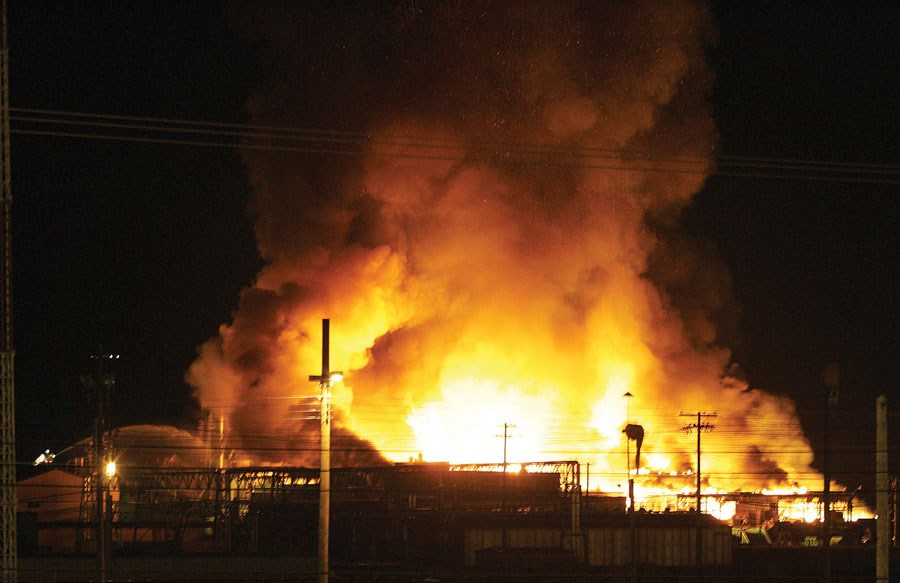Ambulance personnel ventured no closer than Lakeland Mills' River Road entrance despite being assured four times by Prince George firefighters that it was safe to do so, an inquest into the explosion that rocked the operation's sawmill heard Monday.
John Lane, was the Prince George Fire Rescue chief at the time of the April 23, 2012 disaster that killed two men and injured 21 others. In a teleconference from Winnipeg, where he is a fire chief, he said several severely injured workers had gathered at a triage station firefighters had set up on the site and were quickly running out of supplies to treat the burns.
By that time, Lane said the fire that followed the explosion was no longer spreading and assistant fire chief Drew Larsen called PGFR's fire dispatch to relay a message to the B.C. Ambulance Service dispatch saying it was safe to come closer.
But none came nearer, and so Lane said he drove his pickup truck, which was unmarked but equipped with emergency lighting, out to the two ambulances that were stationed at Lakeland Mill's entrance and told one of the paramedics they were needed in the yard to pick up patients.
According to a letter Lane wrote to BCAS executive director Mike Michalko following the disaster, the distance from the command post to the nearest part of the fire was 400 metres and River Road was a further 400 metres away.
Lane then drove back to the PGFR command post where one of the patients was Alan Little, one of the men who subsequently died from the extensive burns he suffered. When they saw an ambulance pull in to the driveway, then stop, back out and drive away, Lane said firefighters were "dumbfounded, but we realized we had to do something on our own."
Little, who was on a clamshell stretcher, was put into the back of Lane's pickup but, because it was a short box, the gate had to be left down making it unsafe to take Little all the way to the University Hospital of Northern British Columbia.
Instead, Lane said Little was taken to the ambulance on River Road. But the paramedic at the scene said he could not take Little because he was acting as the ambulances' command post.
"Really out of desperation," firefighters opened the back of the ambulance, took out its stretcher and placed Little on it and put him in the back of the vehicle. Lane said the ambulance paramedic was at least more qualified to attend to Little than they were.
According to Lane's letter, the first radio call for an ambulance on site was made at 9:46 p.m. and Little was take out to River Road about 20 minutes later. About five minutes after that, then deputy chief John Iverson used his sport utility vehicle to take four patients out to River Road and then found himself taking five - including Glenn Roche, who also died in the fire - to hospital because there were no ambulances available.
In response, Michalko, who testified following Lane, said ambulance paramedics did not want to venture any closer in part for safety reasons but also out of concern they would have to relocate if the smoke shifted or the fire expanded.
In deciding whether to move any closer, ambulance personnel rely on advice from a technical advisor employed by BCAS. They often provide advice over the phone because they're spread throughout the province and often cannot be at the actual location but Michalko said there was one in Prince George.
Contacted at 9:42 p.m., the technical advisor went to the scene and provided an assessment, Michalko said, before he went back to the hospital to aid patients. And as Lane was taking patients out to River Road, paramedics were still hearing explosions from the sawmill, Michalko said.
The final decision on whether to move closer ultimately rests with the paramedics themselves, the inquest heard.
"We don't jump in the river, we don't climb the mountain and certainly we don't into the burning buildings to retrieve patients," Michalko said. "Our function is to have patients brought to us at a reasonable staging area."
Fielding questions from the inquest's six-man jury, Michalko agreed it would be helpful for technical advisors to talk directly to firefighters when assessing a scene.
Asked why an ambulance was being used as a command centre instead of transporting patients, Michalko said a B.C. Ambulance Service's supervisor's response truck, which is equipped with a radio, can also do the job. However, a supervisor was not on the scene until 10:27 p.m.
Since the disaster, Michalko said a "combined events radio channel" has been created that allows ambulance personnel and firefighters to talk directly to one another rather than through their respective dispatches.
The inquest continues today at the Prince George courthouse, 9 a.m. start.



